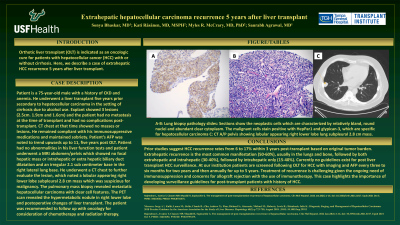Tuesday Poster Session
Category: Liver
P3887 - Extrahepatic Hepatocellular Carcinoma Recurrence 5 Years After Liver Transplant
Tuesday, October 24, 2023
10:30 AM - 4:00 PM PT
Location: Exhibit Hall

Has Audio
- SB
Sonya Bhaskar, MD
University of South Florida
Tampa, Florida
Presenting Author(s)
Sonya Bhaskar, MD1, Myles R.. McCrary, MD, PhD1, Kati Räsänen, MD, MSPH1, Saurabh Agrawal, MD2
1University of South Florida, Tampa, FL; 2Tampa General Hospital/ University of South Florida, Tampa, FL
Introduction: Orthotic liver transplant (OLT) is indicated as an oncologic cure for patients with hepatocellular cancer (HCC) with or without cirrhosis. Here, we describe a case of extrahepatic HCC recurrence 5 years after liver transplant.
Case Description/Methods: Patient is a 75-year-old male with a history of CKD and anemia. He underwent a liver transplant five years prior secondary to hepatocellular carcinoma in the setting of cirrhosis due to alcohol use. Explant showed 3 lesions (2.5cm. 1.9cm and 1.6cm) and the patient had no metastasis at the time of transplant and had no complications post-transplant. CT chest at that time showed no masses or lesions. He remained compliant with his immunosuppressive medications and maintained sobriety. Patient’s AFP was noted to trend upwards up to 11, five years post OLT. Patient had no abnormalities in his liver function tests and patient underwent a MRI abdomen/pelvis which showed no focal hepatic mass or intrahepatic or extra hepatic biliary duct dilatation and an irregular 2.1 sub centimeter base in the right lateral lung base. He underwent a CT chest to further evaluate the lesion, which noted a lobular appearing right lower lobe subpleural 2.8 cm mass which was suspicious for malignancy. The pulmonary mass biopsy revealed metastatic hepatocellular carcinoma with clear cell features. The PET scan revealed the hypermetabolic nodule in right lower lobe and postoperative changes of liver transplant. The patient was recommended to follow up with oncology for consideration of chemotherapy and radiation therapy.
Discussion: Prior studies suggest HCC recurrence rates from 6 to 17% within 3 years post-transplant based on original tumor burden. Extrahepatic recurrence is the most common manifestation (50-60%), usually in the lungs and bone, followed by both extrahepatic and intrahepatic (30-40%), followed by intrahepatic only (15-40%). Currently no guidelines exist for post liver transplant HCC surveillance. At our institution patients are screened following OLT for HCC with imaging and AFP every three to six months for two years and then annually for up to 5 years. Treatment of recurrence is challenging given the ongoing need of immunosuppression and concerns for allograft rejection with the use of immunotherapy. This case highlights the importance of developing surveillance guidelines for post-transplant patients with history of HCC.

Disclosures:
Sonya Bhaskar, MD1, Myles R.. McCrary, MD, PhD1, Kati Räsänen, MD, MSPH1, Saurabh Agrawal, MD2. P3887 - Extrahepatic Hepatocellular Carcinoma Recurrence 5 Years After Liver Transplant, ACG 2023 Annual Scientific Meeting Abstracts. Vancouver, BC, Canada: American College of Gastroenterology.
1University of South Florida, Tampa, FL; 2Tampa General Hospital/ University of South Florida, Tampa, FL
Introduction: Orthotic liver transplant (OLT) is indicated as an oncologic cure for patients with hepatocellular cancer (HCC) with or without cirrhosis. Here, we describe a case of extrahepatic HCC recurrence 5 years after liver transplant.
Case Description/Methods: Patient is a 75-year-old male with a history of CKD and anemia. He underwent a liver transplant five years prior secondary to hepatocellular carcinoma in the setting of cirrhosis due to alcohol use. Explant showed 3 lesions (2.5cm. 1.9cm and 1.6cm) and the patient had no metastasis at the time of transplant and had no complications post-transplant. CT chest at that time showed no masses or lesions. He remained compliant with his immunosuppressive medications and maintained sobriety. Patient’s AFP was noted to trend upwards up to 11, five years post OLT. Patient had no abnormalities in his liver function tests and patient underwent a MRI abdomen/pelvis which showed no focal hepatic mass or intrahepatic or extra hepatic biliary duct dilatation and an irregular 2.1 sub centimeter base in the right lateral lung base. He underwent a CT chest to further evaluate the lesion, which noted a lobular appearing right lower lobe subpleural 2.8 cm mass which was suspicious for malignancy. The pulmonary mass biopsy revealed metastatic hepatocellular carcinoma with clear cell features. The PET scan revealed the hypermetabolic nodule in right lower lobe and postoperative changes of liver transplant. The patient was recommended to follow up with oncology for consideration of chemotherapy and radiation therapy.
Discussion: Prior studies suggest HCC recurrence rates from 6 to 17% within 3 years post-transplant based on original tumor burden. Extrahepatic recurrence is the most common manifestation (50-60%), usually in the lungs and bone, followed by both extrahepatic and intrahepatic (30-40%), followed by intrahepatic only (15-40%). Currently no guidelines exist for post liver transplant HCC surveillance. At our institution patients are screened following OLT for HCC with imaging and AFP every three to six months for two years and then annually for up to 5 years. Treatment of recurrence is challenging given the ongoing need of immunosuppression and concerns for allograft rejection with the use of immunotherapy. This case highlights the importance of developing surveillance guidelines for post-transplant patients with history of HCC.

Figure: A-B: Lung biopsy pathology slides: Sections show the neoplastic cells which are characterized by relatively bland, round nuclei and abundant clear cytoplasm. The malignant cells stain positive with HepPar1 and glypican-3, which are specific for hepatocellular carcinoma
C: CT A/P pelvis showing lobular appearing right lower lobe lung subpleural 2.8 cm mass.
C: CT A/P pelvis showing lobular appearing right lower lobe lung subpleural 2.8 cm mass.
Disclosures:
Sonya Bhaskar indicated no relevant financial relationships.
Myles McCrary indicated no relevant financial relationships.
Kati Räsänen indicated no relevant financial relationships.
Saurabh Agrawal: Astra Zeneca – Advisor or Review Panel Member.
Sonya Bhaskar, MD1, Myles R.. McCrary, MD, PhD1, Kati Räsänen, MD, MSPH1, Saurabh Agrawal, MD2. P3887 - Extrahepatic Hepatocellular Carcinoma Recurrence 5 Years After Liver Transplant, ACG 2023 Annual Scientific Meeting Abstracts. Vancouver, BC, Canada: American College of Gastroenterology.
